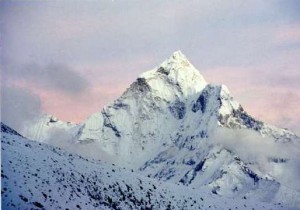I’m sure you’ve heard some version of the old phrase, “not being able to see the forest for the trees”. There are many such aphorisms, so—clearly—one’s inability to see big pictures owing to focus on details is not a new phenomenon.
I came across an inverse view of this recently. A two-gigabyte image of Mt. Everest and its environs recently crossed my inbox. At first glance, it’s impossible to fully grasp the size of what’s presented, and not because of the details: They’re so minuscule that they’re not even noticed. Without adjusting the viewpoint, see if you can spot the yellows and oranges of the tents at the basecamp at the lower-right-center of the image. That alone will give you some insight as to what’s in your field of view. Then experiment with the controls to see just how far you have to move in to see any details—not just of the basecamp, but of any specific aspect of this incredible location.
Make the effort to visit this site. It’s exciting, fascinating…and more than a bit humbling.
Questions: How sure are you that you see everything when you look at something? What “blindnesses” are you applying when viewing a scene or a situation? How can you insure against missing something—either big- or small-picture? What are the consequences, in either case?

